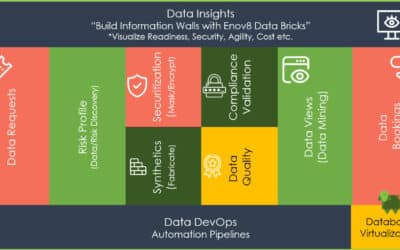A DevOps Approach to Test Data Management
MAR, 2023
by Andrew Walker.
Author Andrew Walker
Andrew Walker is a software architect with 10+ years of experience. Andrew is passionate about his craft, and he loves using his skills to design enterprise solutions for Enov8, in the areas of IT Environments, Release & Data Management.
DevOps has become a popular approach to software development and delivery, aiming to bring together development and operations teams to build and release software more quickly, reliably, and efficiently. The DevOps approach emphasizes collaboration, automation, and continuous delivery, which has revolutionized the way organizations build and deliver software products. However, one critical aspect of DevOps that is often overlooked is test data management.
”Enov8
*aka ‘Data Compliance Suite’
The Data Securitization and Test Data Management platform. DevSecOps your Test Data & Privacy Risks.
Test data is the foundation of software testing, and it is crucial to ensure that it is accurate, diverse, and representative of the production environment. Poor test data management can lead to failed releases, production issues, and delayed time-to-market.
In this blog post, we will explore the importance of effective test data management in the DevOps approach and discuss techniques for achieving it. We will also highlight the benefits of using automation and collaboration in test data management and provide some tips for getting started. Ultimately, this post aims to show how adopting a DevOps approach to test data management can help organizations improve the quality, speed, and cost-effectiveness of software development.
The Importance of Test Data Management in DevOps
Test data management plays a crucial role in the success of DevOps implementation. Test data provides the foundation for software testing and quality assurance, enabling developers and testers to ensure that software products function correctly and meet customer requirements. Effective test data management ensures that test data is accurate, diverse, and representative of the production environment, enabling developers to identify and fix defects early in the development cycle.
Poor test data management can lead to a wide range of issues, such as failed releases, production defects, and delayed time-to-market. For example, if test data is not representative of the production environment, it may not identify defects that may occur in the actual production environment, leading to production issues. If test data is not diverse, it may not test all possible scenarios, leading to software products that do not meet customer requirements. If test data is not accurate, it may lead to false positives or false negatives, resulting in wasted time and resources.
Therefore, it is crucial for organizations to invest in effective test data management to ensure that they can deliver high-quality software products quickly, reliably, and efficiently. Effective test data management helps organizations reduce costs, improve software quality, and increase customer satisfaction by identifying defects early in the development cycle and ensuring that software products meet customer requirements. In the next section, we will discuss different techniques that organizations can use to achieve effective test data management in the DevOps approach.
Enov8 TDM, DevOps that Data: Screenshot
Techniques for Effective Test Data Management
There are several techniques that organizations can use to achieve effective test data management in the DevOps approach. These techniques aim to ensure that test data is accurate, diverse, and representative of the production environment, enabling developers and testers to identify and fix defects early in the development cycle.
- Data Virtualization – Data virtualization, also called Data Cloning, is a technique that allows developers and testers to access and manipulate test data without the need for physical copies. This technique enables organizations to create virtual copies of data that can be accessed and manipulated by multiple teams simultaneously, reducing the need for multiple physical copies of data. Data virtualization also allows organizations to create test environments that are identical to the production environment, reducing the risk of production issues.
- Data Masking – Data masking is a technique that involves replacing sensitive data with non-sensitive data during the testing process. This technique ensures that sensitive data is not exposed during the testing process, reducing the risk of data breaches. Data masking can also help organizations comply with data privacy regulations such as GDPR and CCPA.
- Data Subsetting – Data subsetting is a technique that involves creating a subset of test data that is representative of the production environment. This technique enables organizations to reduce the amount of test data needed for testing while ensuring that the test data is diverse and representative of the production environment. Data subsetting also helps reduce the storage requirements for test data.
- Data Fabrication – Data Fabrication, also known as data synthetics, is a technique that involves creating fake data that mimics the characteristics of real data. This technique enables organizations to create test data that is not available in the production environment, such as extreme or rare scenarios, and to test the system’s response to those scenarios. Data fabrication can also be used to create test data when real data is not available or too expensive to acquire.
These techniques can be used individually or in combination to achieve effective test data management in the DevOps approach. The choice of technique(s) will depend on the organization’s specific needs and requirements. In the next section, we will discuss how automation and collaboration can help organizations achieve effective test data management in the DevOps approach.
Automation and Collaboration in Test Data Management
Automation and collaboration are critical elements in achieving effective test data management in the DevOps approach. With the rapid pace of development in a DevOps environment, manual processes are no longer sufficient for managing test data. Automated processes can help organizations create, manage, and refresh test data quickly and efficiently, reducing the time and effort required for testing.
- Test Data Automation Test data automation involves automating the processes of creating, managing, and refreshing test data. This technique enables organizations to create and manage test data quickly and efficiently, reducing the risk of human error and ensuring the accuracy of the test data. Test data automation can also be used to automatically mask or subset test data as required, ensuring the security and compliance of the test data.
- Collaboration Collaboration between different teams involved in the DevOps process, such as developers, testers, and operations, is critical for effective test data management. Collaboration enables teams to share knowledge and expertise, ensuring that the test data is representative of the production environment and that defects are identified and fixed early in the development cycle. Collaboration can also help teams identify opportunities for improving test data management processes and techniques.
- Continuous Integration and Continuous Delivery (CI/CD) Continuous integration and continuous delivery (CI/CD) practices enable organizations to automate the entire software development and deployment process, including test data management. With CI/CD, developers can continuously integrate and test code changes, ensuring that defects are identified and fixed early in the development cycle. Test data can be automatically refreshed and managed as part of the CI/CD process, ensuring that test data is always up-to-date and representative of the production environment.
Effective test data management requires a combination of automation and collaboration. Automation enables organizations to create and manage test data quickly and efficiently, while collaboration ensures that the test data is representative of the production environment and that defects are identified and fixed early in the development cycle. (http://rxreviewz.com/) In the next section, we will discuss the benefits of effective test data management in the DevOps approach.
Conclusion
Effective test data management is essential for the success of software development in the DevOps approach. Accurate, diverse, and representative test data enables developers and testers to identify and fix defects early in the development cycle, reducing the risk of production issues and improving software quality.
Organizations can use a range of techniques for effective test data management, including data virtualization, data masking, data subsetting, and data fabrication. Automation and collaboration are also critical elements in achieving effective test data management in the DevOps approach. Test data automation enables organizations to create and manage test data quickly and efficiently, while collaboration enables teams to share knowledge and expertise, ensuring that test data is representative of the production environment.
To achieve effective test data management, and DataOps in general, organizations can consider using Enov8 Test Data Manager, a comprehensive solution designed to help teams manage, automate and govern their test data operations. Enov8 Test Data Manager allows teams to quickly create and manage test data, ensuring that it is diverse, representative, and compliant with data privacy regulations.
Effective test data management can provide several benefits to organizations, including reduced time-to-market, improved software quality, and reduced costs associated with testing. By adopting a DevOps approach to test data management and leveraging tools like Enov8 Test Data Manager, organizations can achieve these benefits and stay ahead in today’s competitive business landscape.
Other TDM Reading
Explore Test Data Management further:
Enov8 Blog: What makes a good Test Data Manager?
Enov8 Blog: TDM Strategy Design Guide Best Practices
Enov8 Blog: Why TDM is so Important!
Relevant Articles
8 DevOps Anti-Patterns to Avoid
It’s the normal case with software buzzwords that people focus so much on what something is that they forget what it is not. DevOps is no exception. To truly embrace DevOps and cherish what it is, it’s important to comprehend what it isn’t. A plethora...
An Introduction to Application Rationalization
In today's fast-paced digital landscape, organizations often find themselves grappling with a sprawling array of applications. While these applications are crucial for various business operations, the lack of a structured approach to managing them can lead to...
What Makes a Great Test Data Management Tool
What Makes a Great Test Data Management Tool? In today's fast-paced IT landscape, having a robust Test Data Management (TDM) tool is crucial for ensuring quality, compliance, and efficiency in software development and testing. At Enov8, we pride ourselves on providing...
The Top Application Portfolio Management Tools
Managing an application portfolio is essential for organizations aiming to optimize their IT operations, reduce costs, and enhance overall efficiency. Application Portfolio Management (APM) tools are designed to help organizations achieve these goals by providing a...
What Is a Test Data Manager?
Testing is a critical aspect of software development, and it requires the use of appropriate test data to ensure that the software performs optimally. Test data management (TDM) is the process of creating, storing, and managing test data to ensure its quality,...
Sprint Scheduling: A Guide to Your Agile Calendar
Agile sprints can be a powerful, productive and collaborative event if managed properly. However, when neglected or set up incorrectly they risk becoming chaotic and inefficient. Crafting an effective schedule for your sprint is essential to ensure the success of your...
What is Database Virtualization? A Complete Explanation
In today’s data-driven world, businesses are constantly looking for ways to streamline their data management processes and maximize the value of their data assets. One approach that has gained popularity in recent years is virtualization, which allows multiple virtual...
What is Data Operations (DataOps)? A Detailed Explanation
Businesses across the board are spinning their tires when it comes to data and analytics, with many of them failing to unlock maximum value from their investments. According to one study, 89% of companies face challenges around how they manage data. While...
What Is the Role of a Release Train Engineer?
The software development industry is constantly evolving. And as such, new techniques of creating, releasing, and deploying software solutions are emerging. With the emergence of these new techniques comes new job roles and descriptions never seen before. Ever...
RAG Status and Its Role in Technology Leadership
Effective Leadership requires effective tooling to drive successful outcomes. One tool they can use to monitor and measure progress is RAG status. RAG stands for Red, Amber, Green, and is a simple traffic light system used to communicate the current status of a...












